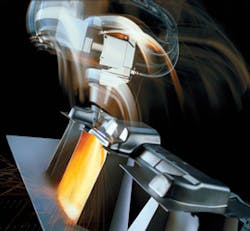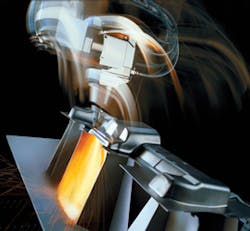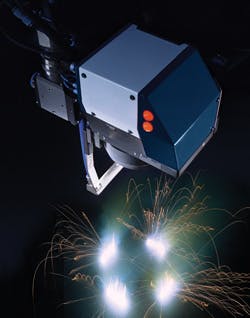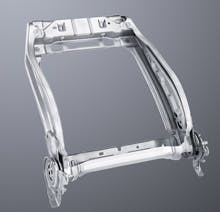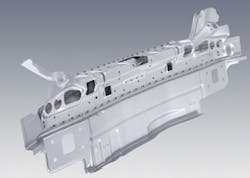Disk lasers for automotive applications
Though the disk laser concept was established in the early 1990s, ongoing developments have increased the power per disk, and continue to improve beam quality and efficiency. Even at the current 6 kW per disk, this unique laser principle has not reached any fundamental limits regarding output power per disk or beam quality. The disk laser concept has established itself as a premier and flexible design for the future of industrial laser processing.
A smaller footprint and a reduction in the costs of investment and operation have driven manufacturers to implement disk laser technology with more vigor than ever. With 3000 high power disk laser installations for applications such as cutting, welding, hybrid laser welding, and laser metal deposition, and demand upward of 1000 lasers per year, the disk laser has proven to be a robust and reliable industrial tool. Here, we will explore three industrial applications where the disk laser is a suitable partner to the process.
Cutting hot-formed steel
In the automotive sector, the cutting of hot-formed components has become an extremely important and growing application. However, while the extremely high strength of the components (e.g., tensile strengths typically greater than 1500 MPa) decreases mass and increases passenger safety, new processing challenges arise: conventional shearing tools will wear too quickly and as-sheared edges are often plagued with micro-cracks. As a result, laser processing is the only viable method for cutting hot-formed parts in high volume production. The high beam quality (4 mm-mrad) found in the 3 kW and 4 kW disk lasers is a good match for cutting ultra strong three-dimensional (3-D) parts. In this case, the disk laser is coupled with a TruLaser Cell 8030, a multi-axis system design specifically for the hot-formed cutting market (FIGURE 1). The excellent beam quality and short wavelength, combined with the highly dynamic and robust multi-axis system, offer manufacturers high throughput in the harsh and extremely demanding automotive manufacturing environment.
But why the disk laser? To illustrate its advantages, let’s consider an automotive B-pillar case study with 6305 mm of laser cutting in a 1.8 mm thick material. In 2005, this pillar could be cut in ~120 seconds with a 3.2 kW CO2 laser. If we ran the same part today, using a 4 kW disk laser, the coupling advantages of the disk laser’s 1 micron wavelength, improvements in system dynamics, and a slight increase in laser power allows us to complete the job in less than 47 seconds. We would save 73 seconds, or rather, in the time it took to cut one part with a CO2 laser, we could cut more than 2.5 parts with a disk laser.
Welding in powertrain
For years, laser welding of powertrain components has been performed with CO2 lasers using helium as the shielding and plasma suppression gas. Due to the rising costs of helium and its unpredictable availability, manufacturers have been investigating alternate high energy beam solutions, such as the disk laser because its wavelength requires no gas at all or enables argon to be used as a shielding gas. The disk laser provides the high beam power to meet the penetration and throughput requirements, as well as the excellent beam quality and focusability needed to insure minimum heat input and low distortion. This laser also has a wall plug efficiency (WPE) close to 30%, compared to the roughly 10% WPE of the CO2 laser, giving manufacturers an added economic incentive. The typical shape of a disk laser weld is shown in FIGURE 2, which demonstrates the high aspect ratio of the welding seam.
There are a variety of butt and overlap joints applications in gear manufacturing, all of which can be joined with the disk laser. FIGURE 3 shows a shaft-to-collar joint. The welding depth of 3 mm was achieved with a 3 kW disk laser and a welding speed of 3 m/min. Due to the very slim joint geometry, it is also possible to weld varying material combinations. FIGURE 4 shows a cross section of a differential joint, where tempered steel (16MnCr5) was laser welded to cast iron (GGG 60). Normally, one would expect an extreme increase of hardness in the fusion zone, which would lead to cracks and greatly compromise the weld. To avoid this, a filler wire (NiBAS 70/20) is used, reducing the hardness within the fusion zone for a more homogenized weld. Spikes of hardness and resultant cracks can be avoided. The differential was welded with a 3.5 kW disk laser at a welding speed of 2 m/min, with a penetration depth of ~3.2 mm.
Laser scanner welding
Remote laser welding is a common and successful global application of the disk laser. Many automotive companies and their suppliers (e.g., the seat industry) rely on disk laser technology and have integrated remote welding into their production lines. Some of the well known applications can be found at Daimler, as well Audi and Volkswagen. The disk is ideally suited for this application for several reasons:
- The fiber delivered beam allows for robotic welding on the fly.
- The power and beam quality are ideal for remote scanner welding.
- The wavelength enables processing without shielding gas.
- The high WPE and extremely long diode life result in a very low operating cost.
- The laser’s compact size and fiber delivery enable flexible use of floor space.
- The multiple fiber output option allows efficient and flexible use of laser sources.
The biggest advantage of the remote welding process is the extremely high productivity because inefficient and unproductive periods between welding steps can be essentially eliminated. Therefore, the laser, as a welding tool, can be used in the most efficient way possible. In conventional laser welding applications, laser on-time is roughly 30-40%, but with remote laser processing, on-time can be up to 90%. So compared to conventional resistant spot welding, the process speed can be increased by a factor of 3 to 10 times.
Another advantage of remote laser welding is the high flexibility of the weld pattern. For example, manufacturers can optimize the load performance of the as-welded component by adapting the geometry of the seam to the actual stresses at the weld joint. The seam geometry can also be modified to space requirements. While a slim flange leads to slim C-shape or linear welding geometries, circular C-shapes or other broad geometries can be chosen for larger areas. FIGURES 5 to 7 show a selection of remote welding applications.
Conclusion
Due to the modular and flexible concept of the disk laser, the output power and beam quality are easily adapted to a wide array of automotive and other applications. The disk laser demonstrates the versatility in beam quality and power necessary to meet the demands of the key global industrial markets. In high speed cutting of hot-formed components, welding of powertrain components and welding on the fly, the disk laser expands upon its decades-long history and proven success across an ever-growing industrial base. ✺
David Havrilla ([email protected]) is manager - products & applications at Trumpf Inc. in Plymouth, MI.
More Industrial Laser Solutions Current Issue Articles
More Industrial Laser Solutions Archives Issue Articles
About the Author
David Havrilla
Manager of Products and Applications, TRUMPF Laser Technology Center
David Havrilla is the manager of products and applications at the TRUMPF Laser Technology Center (Plymouth, MI).
